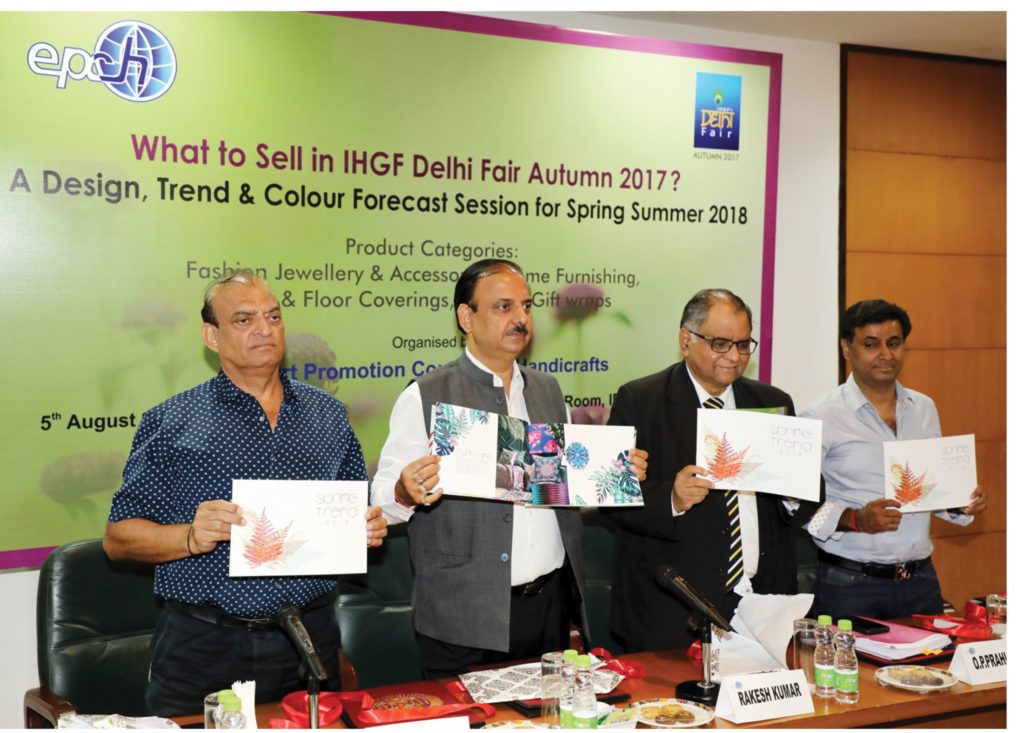Q. What is the structure of EPCH?
A. EPCH works as an autonomous body setup up by the trade in industry collectively along with the govt. where stake holders are the private sectors and the gov. is also supporting them for their activities. EPCH was setup way back in 1986 and since then we have been working for the promotion of the exports of handicrafts. The industry scale and size was very minuscule at that time. We had only 37 members when we started the functioning of EPCH. I am really very proud to be associated with the EPCH since its inception. Today we have grown by leaps and bonds and we are the largest export promotion council in the country having over 11000 members.
Q. What are the major activities which are undertaken by EPCH for the welfare of its members?
A. EPCH undertakes lot of activities for the promotion of the exports from the country. One of the major activities of the council is participation in the trade fairs in India and Abroad. EPCH is organising its participation of the members in about 40 overseas trade shows, beside that we organise two mega Trade Fairs in India, which are world’s leading shows on handicrafts and these are called IHGF Delhi fair Spring and Autumn. These shows are basically a Mecca for the handicraft sector where participants meet a large number of overseas buyers. It’s like a KUMBH of the entire handicraft sector which takes place twice a year, once in October and another in April.
At the same time, we have a lot of backward integration which means we have a kind of a complete supply chain of the products. Backward integration starts with the craft person, which are over 7 million in the country today. A lot of skill programmes are also organised for them. We have our presence directly in 17 clusters,. With 17 offices all over the country, we are present from Kashmir to Kanyakumari, we have our presence in all the 8 states in the north eastern region, Bangalore for the South, and even in the clusters like Moradabad, Saharanpur, Jodhpur.
We have a complete existence by way of setting up of the common facility centre, wood seasoning plant and also the trade facilitation centre. So these ways we have a backward integration for our members, for our exporters, as well as for the handicraft sector. We also run an academy which trains the budding exporters & people for the industry who can really work as a smart professionals for our industry. We have testing labs which are setup in Jaipur. We also have our own standard of the compliance of the wooden handicraft such as the Vriksh which is accepted by about 186 countries by the United Nation’s body called CITES (the Convention on International Trade in Endangered Species of Wild Fauna and Flora). CITES has accepted our standard on woods – Vriksh. Now any buyer who buys our product knows that the entire wooden handicraft coming from India is from the legal procurement so there is no illegal cutting of the tree.
We also help our members in marketing and promotion. We are also having seat in many committees of the government, and hence we act as a complete mouthpiece for the handicraft sector.
Q. What is the size of Indian handicraft sector and what would be the statistics like?
A. The handicraft exports in 1987 when we started was nearly 286 crores and today we have reached exports of over 25000 crores which is around $4 billion. The growth rate is approximately 12-15% p.a. which is not to be witnessed in many sectors . At the same time the artisans number has also increased, their wages have increased, the exporters incomes have also increased, so i think that the entire size and scale of the handicraft sector has also grown in a big way.
Q. If we talk about the major export markets what would they be like top 3-4 countries where we export?
A. See handicraft products are basically exported to affluent countries. I would say that out of the total exports 36% of the export is goes to USA and Canada whereas another 37% of the export is to the European union so all together these two basket 73% of the total exports.
Q. If we talk about the major challenges which your industry is facing currently what would be the top 3 challenges which you are facing?
A. The most critical challenge is product development because so far we are still working largely on handmade procedures so lot technology upgradation is required in the sector. This is the one important aspect required. Next, we can say about the design. Design is also one of the most important aspect of any item because every time the buyer ask what is the novelty, what is new? We are basically in the market of the gift, market of the home, lifestyle, fashion, furniture etc. so the design is one of the most important aspects and that way sector still facing a challenge in regard to good designs.
Next, its the packaging. Now we export our products from one warehouse to another, but it is required today that the product should be finally packed the way it is going to be sourced to the consumer , departmental store, shop, wherever they are ready to be sold.
Lastly, the government should get more involved by suggesting the ways and means to promote the exports. I personally feel if these challenges are met in the coming years then we will definitely go a long way.





















